Project Management Report: Integrated Approach & Risk Management
VerifiedAdded on 2023/06/13
|17
|2949
|98
Report
AI Summary
This report provides a comprehensive overview of key concepts and practices in project management. It begins by discussing an integrated approach to managing projects, emphasizing centralization and its benefits. The report then delves into defining a project, including scope, priorities, and work breakdown structure. A significant portion is dedicated to managing project risks, covering risk management processes, contingency planning, opportunity management, and change control. Resource scheduling is addressed, including resource smoothing, constraint types, and allocation methods. The report further explores leadership in project management, differentiating between managing and leading, and highlighting the importance of stakeholder management, social network building, and ethics. It also examines managing project teams through the five-stage development model and building high-performance teams. Finally, the report discusses project closure, including types of closure, wrap-up activities, and post-implementation evaluation. The report emphasizes practical application and provides insights into effective project management strategies.
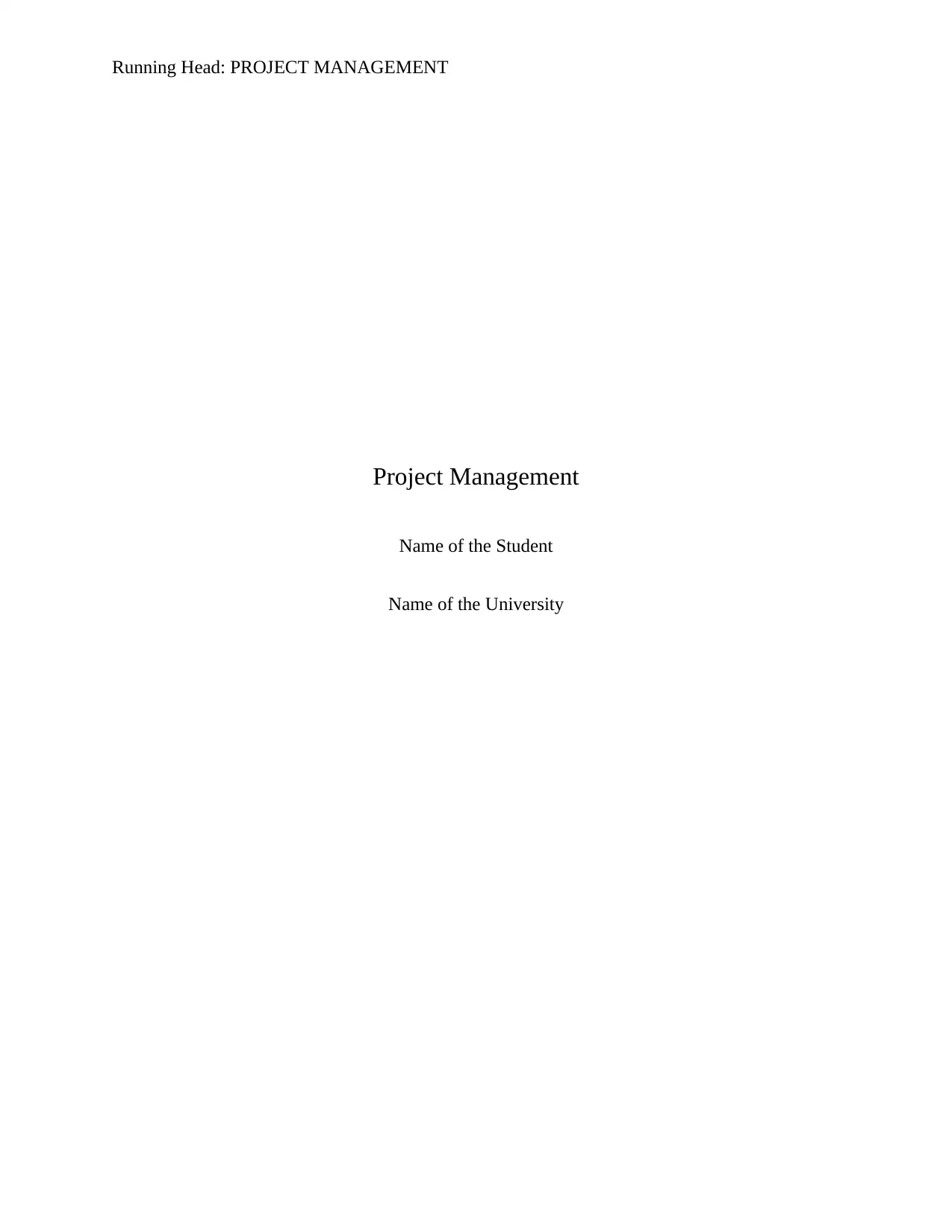
Running Head: PROJECT MANAGEMENT
Project Management
Name of the Student
Name of the University
Project Management
Name of the Student
Name of the University
Paraphrase This Document
Need a fresh take? Get an instant paraphrase of this document with our AI Paraphraser
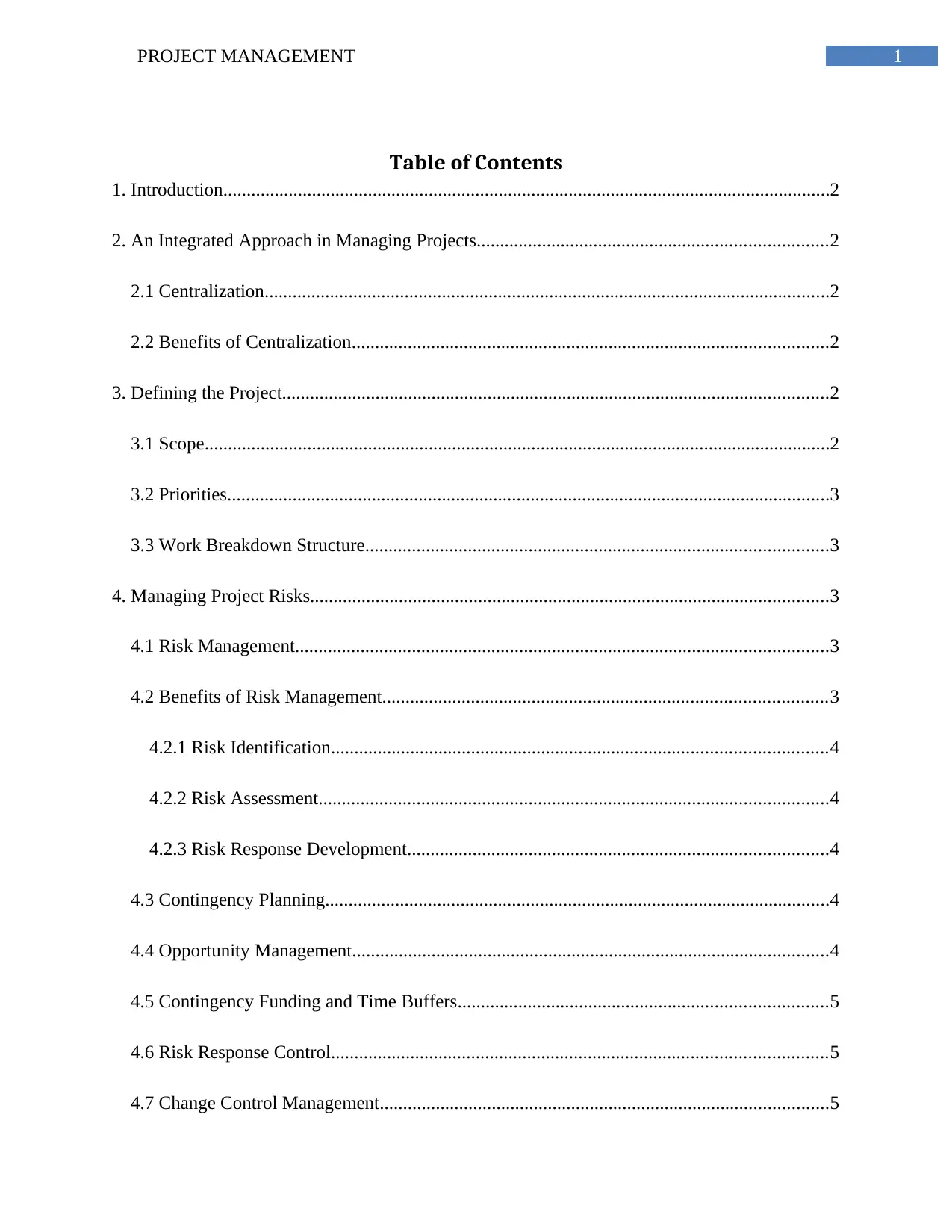
1PROJECT MANAGEMENT
Table of Contents
1. Introduction..................................................................................................................................2
2. An Integrated Approach in Managing Projects...........................................................................2
2.1 Centralization.........................................................................................................................2
2.2 Benefits of Centralization......................................................................................................2
3. Defining the Project.....................................................................................................................2
3.1 Scope......................................................................................................................................2
3.2 Priorities.................................................................................................................................3
3.3 Work Breakdown Structure...................................................................................................3
4. Managing Project Risks...............................................................................................................3
4.1 Risk Management..................................................................................................................3
4.2 Benefits of Risk Management...............................................................................................3
4.2.1 Risk Identification..........................................................................................................4
4.2.2 Risk Assessment.............................................................................................................4
4.2.3 Risk Response Development..........................................................................................4
4.3 Contingency Planning............................................................................................................4
4.4 Opportunity Management......................................................................................................4
4.5 Contingency Funding and Time Buffers...............................................................................5
4.6 Risk Response Control..........................................................................................................5
4.7 Change Control Management................................................................................................5
Table of Contents
1. Introduction..................................................................................................................................2
2. An Integrated Approach in Managing Projects...........................................................................2
2.1 Centralization.........................................................................................................................2
2.2 Benefits of Centralization......................................................................................................2
3. Defining the Project.....................................................................................................................2
3.1 Scope......................................................................................................................................2
3.2 Priorities.................................................................................................................................3
3.3 Work Breakdown Structure...................................................................................................3
4. Managing Project Risks...............................................................................................................3
4.1 Risk Management..................................................................................................................3
4.2 Benefits of Risk Management...............................................................................................3
4.2.1 Risk Identification..........................................................................................................4
4.2.2 Risk Assessment.............................................................................................................4
4.2.3 Risk Response Development..........................................................................................4
4.3 Contingency Planning............................................................................................................4
4.4 Opportunity Management......................................................................................................4
4.5 Contingency Funding and Time Buffers...............................................................................5
4.6 Risk Response Control..........................................................................................................5
4.7 Change Control Management................................................................................................5
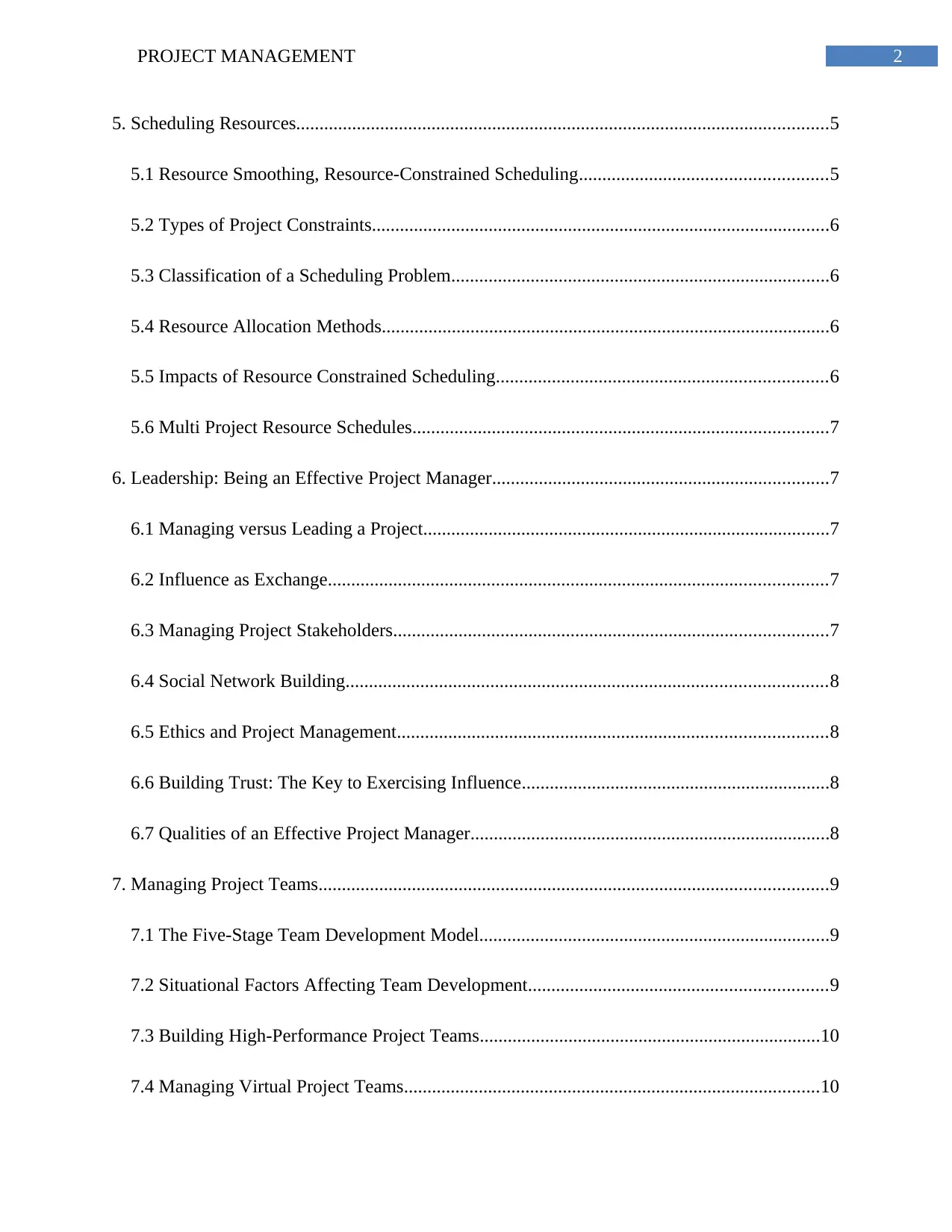
2PROJECT MANAGEMENT
5. Scheduling Resources..................................................................................................................5
5.1 Resource Smoothing, Resource-Constrained Scheduling.....................................................5
5.2 Types of Project Constraints..................................................................................................6
5.3 Classification of a Scheduling Problem.................................................................................6
5.4 Resource Allocation Methods................................................................................................6
5.5 Impacts of Resource Constrained Scheduling.......................................................................6
5.6 Multi Project Resource Schedules.........................................................................................7
6. Leadership: Being an Effective Project Manager........................................................................7
6.1 Managing versus Leading a Project.......................................................................................7
6.2 Influence as Exchange...........................................................................................................7
6.3 Managing Project Stakeholders.............................................................................................7
6.4 Social Network Building.......................................................................................................8
6.5 Ethics and Project Management............................................................................................8
6.6 Building Trust: The Key to Exercising Influence..................................................................8
6.7 Qualities of an Effective Project Manager.............................................................................8
7. Managing Project Teams.............................................................................................................9
7.1 The Five-Stage Team Development Model...........................................................................9
7.2 Situational Factors Affecting Team Development................................................................9
7.3 Building High-Performance Project Teams.........................................................................10
7.4 Managing Virtual Project Teams.........................................................................................10
5. Scheduling Resources..................................................................................................................5
5.1 Resource Smoothing, Resource-Constrained Scheduling.....................................................5
5.2 Types of Project Constraints..................................................................................................6
5.3 Classification of a Scheduling Problem.................................................................................6
5.4 Resource Allocation Methods................................................................................................6
5.5 Impacts of Resource Constrained Scheduling.......................................................................6
5.6 Multi Project Resource Schedules.........................................................................................7
6. Leadership: Being an Effective Project Manager........................................................................7
6.1 Managing versus Leading a Project.......................................................................................7
6.2 Influence as Exchange...........................................................................................................7
6.3 Managing Project Stakeholders.............................................................................................7
6.4 Social Network Building.......................................................................................................8
6.5 Ethics and Project Management............................................................................................8
6.6 Building Trust: The Key to Exercising Influence..................................................................8
6.7 Qualities of an Effective Project Manager.............................................................................8
7. Managing Project Teams.............................................................................................................9
7.1 The Five-Stage Team Development Model...........................................................................9
7.2 Situational Factors Affecting Team Development................................................................9
7.3 Building High-Performance Project Teams.........................................................................10
7.4 Managing Virtual Project Teams.........................................................................................10
⊘ This is a preview!⊘
Do you want full access?
Subscribe today to unlock all pages.

Trusted by 1+ million students worldwide
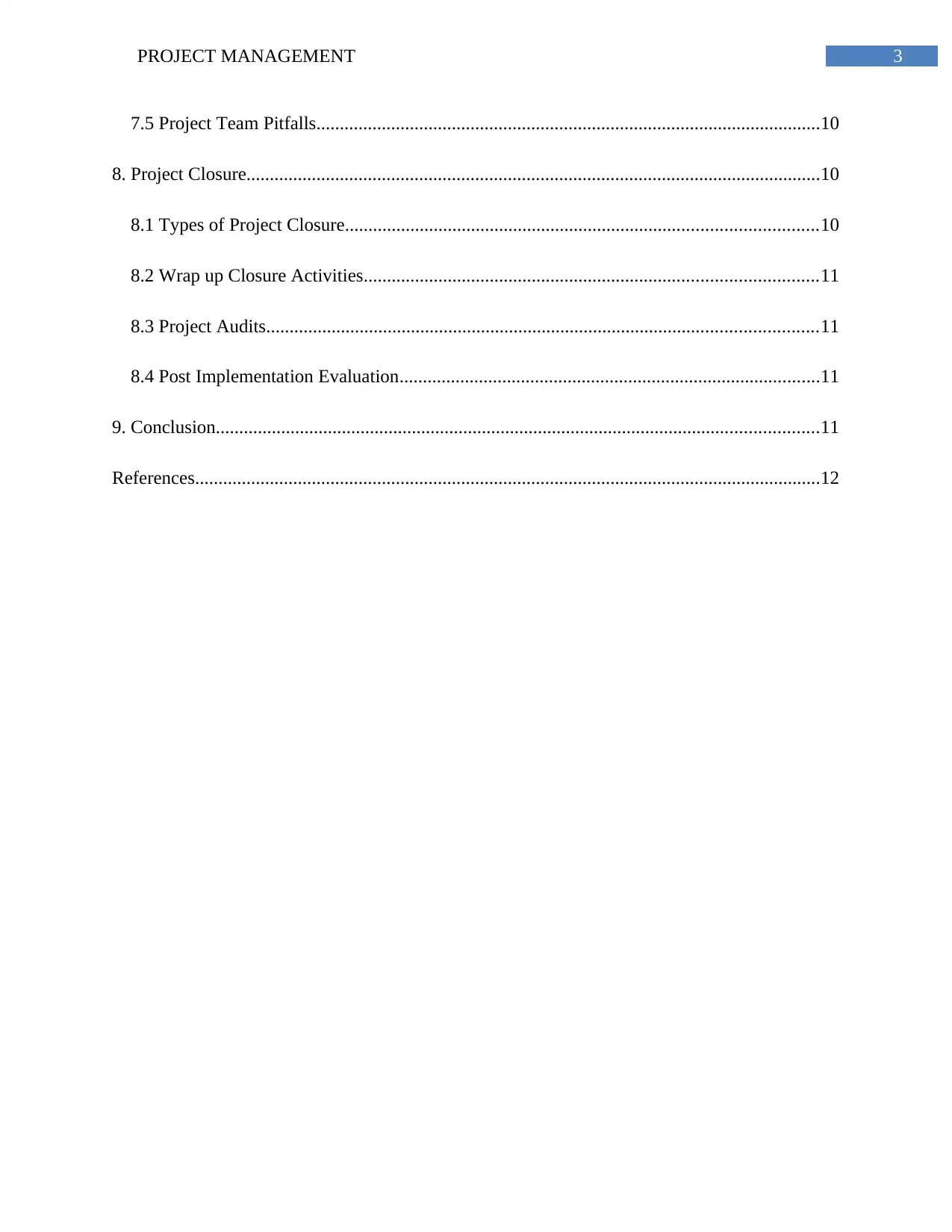
3PROJECT MANAGEMENT
7.5 Project Team Pitfalls............................................................................................................10
8. Project Closure...........................................................................................................................10
8.1 Types of Project Closure.....................................................................................................10
8.2 Wrap up Closure Activities.................................................................................................11
8.3 Project Audits......................................................................................................................11
8.4 Post Implementation Evaluation..........................................................................................11
9. Conclusion.................................................................................................................................11
References......................................................................................................................................12
7.5 Project Team Pitfalls............................................................................................................10
8. Project Closure...........................................................................................................................10
8.1 Types of Project Closure.....................................................................................................10
8.2 Wrap up Closure Activities.................................................................................................11
8.3 Project Audits......................................................................................................................11
8.4 Post Implementation Evaluation..........................................................................................11
9. Conclusion.................................................................................................................................11
References......................................................................................................................................12
Paraphrase This Document
Need a fresh take? Get an instant paraphrase of this document with our AI Paraphraser
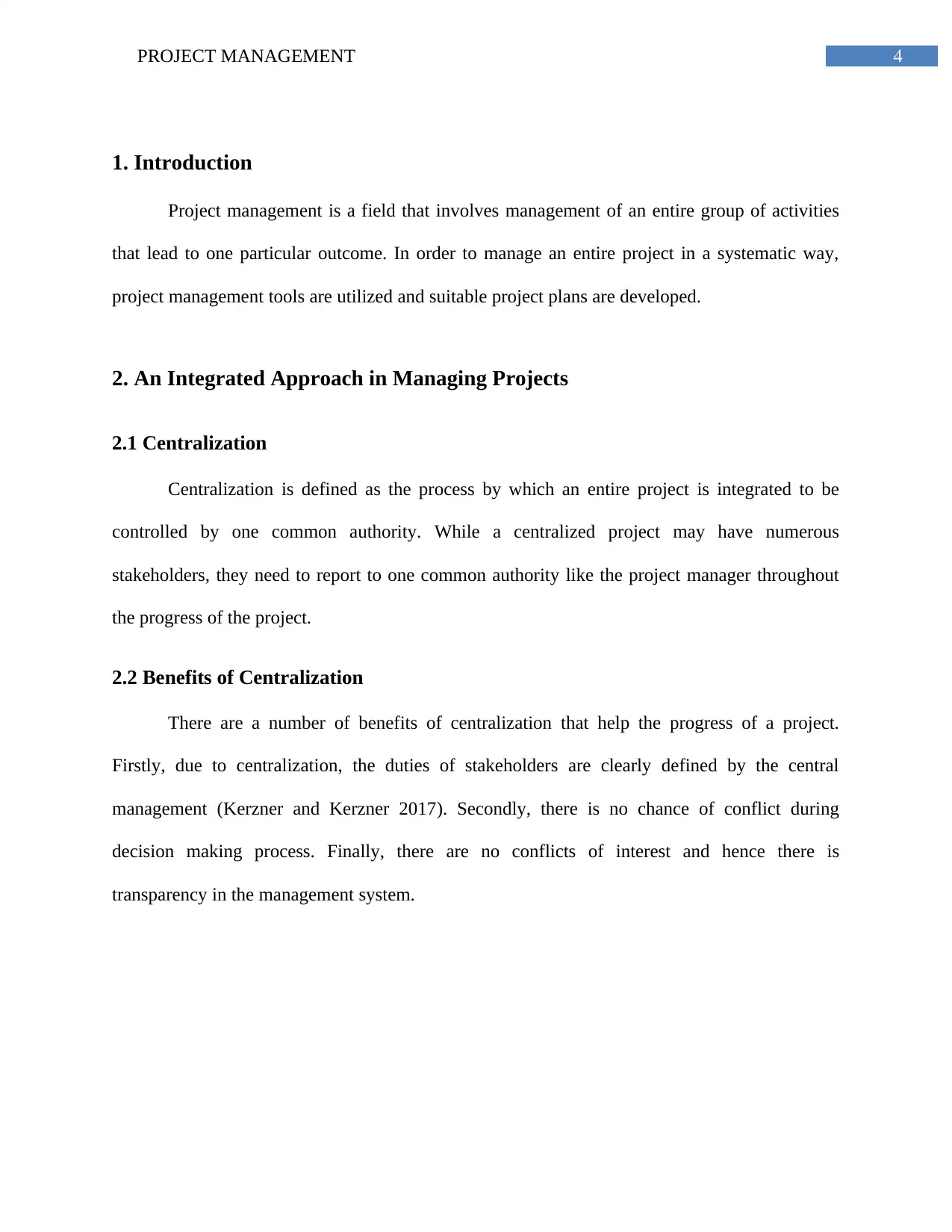
4PROJECT MANAGEMENT
1. Introduction
Project management is a field that involves management of an entire group of activities
that lead to one particular outcome. In order to manage an entire project in a systematic way,
project management tools are utilized and suitable project plans are developed.
2. An Integrated Approach in Managing Projects
2.1 Centralization
Centralization is defined as the process by which an entire project is integrated to be
controlled by one common authority. While a centralized project may have numerous
stakeholders, they need to report to one common authority like the project manager throughout
the progress of the project.
2.2 Benefits of Centralization
There are a number of benefits of centralization that help the progress of a project.
Firstly, due to centralization, the duties of stakeholders are clearly defined by the central
management (Kerzner and Kerzner 2017). Secondly, there is no chance of conflict during
decision making process. Finally, there are no conflicts of interest and hence there is
transparency in the management system.
1. Introduction
Project management is a field that involves management of an entire group of activities
that lead to one particular outcome. In order to manage an entire project in a systematic way,
project management tools are utilized and suitable project plans are developed.
2. An Integrated Approach in Managing Projects
2.1 Centralization
Centralization is defined as the process by which an entire project is integrated to be
controlled by one common authority. While a centralized project may have numerous
stakeholders, they need to report to one common authority like the project manager throughout
the progress of the project.
2.2 Benefits of Centralization
There are a number of benefits of centralization that help the progress of a project.
Firstly, due to centralization, the duties of stakeholders are clearly defined by the central
management (Kerzner and Kerzner 2017). Secondly, there is no chance of conflict during
decision making process. Finally, there are no conflicts of interest and hence there is
transparency in the management system.
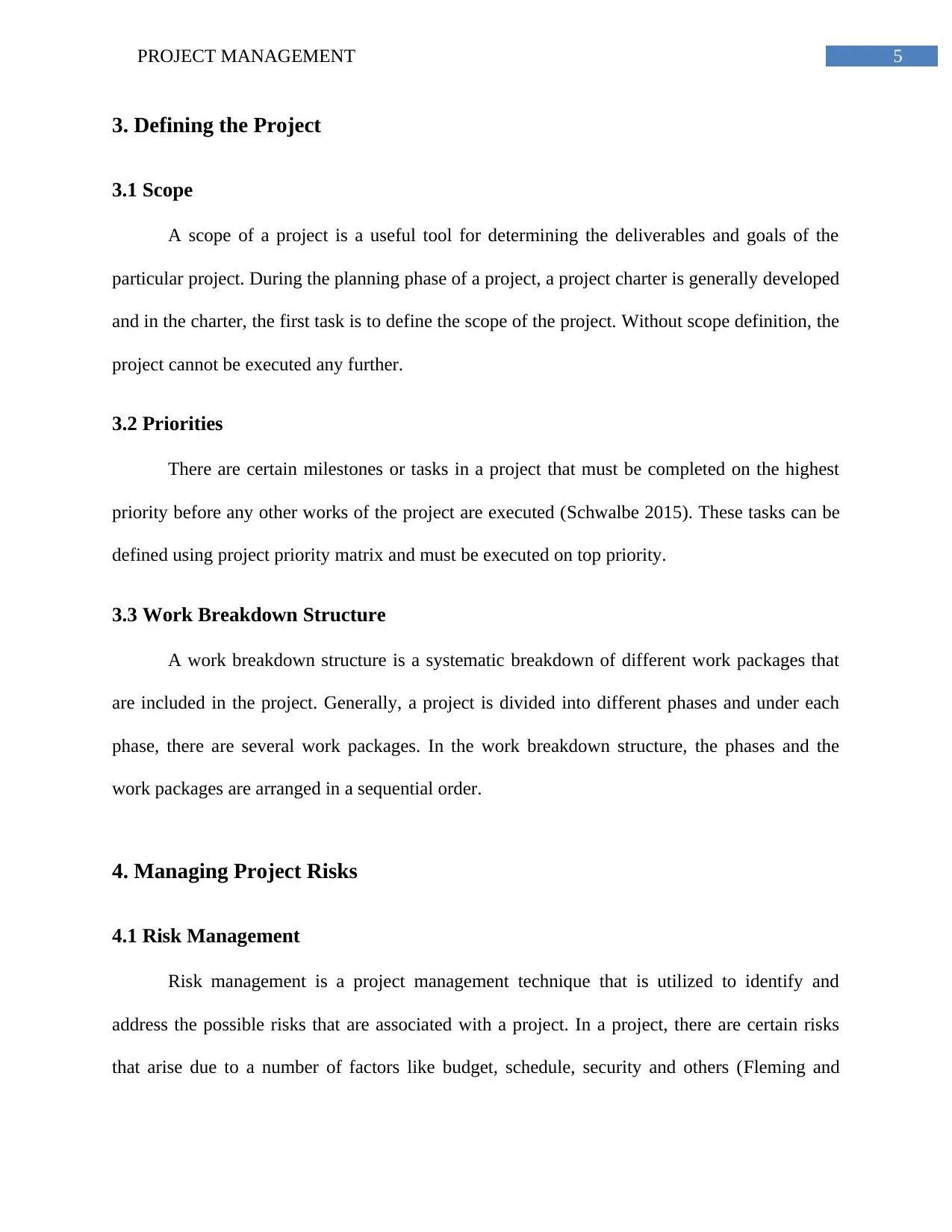
5PROJECT MANAGEMENT
3. Defining the Project
3.1 Scope
A scope of a project is a useful tool for determining the deliverables and goals of the
particular project. During the planning phase of a project, a project charter is generally developed
and in the charter, the first task is to define the scope of the project. Without scope definition, the
project cannot be executed any further.
3.2 Priorities
There are certain milestones or tasks in a project that must be completed on the highest
priority before any other works of the project are executed (Schwalbe 2015). These tasks can be
defined using project priority matrix and must be executed on top priority.
3.3 Work Breakdown Structure
A work breakdown structure is a systematic breakdown of different work packages that
are included in the project. Generally, a project is divided into different phases and under each
phase, there are several work packages. In the work breakdown structure, the phases and the
work packages are arranged in a sequential order.
4. Managing Project Risks
4.1 Risk Management
Risk management is a project management technique that is utilized to identify and
address the possible risks that are associated with a project. In a project, there are certain risks
that arise due to a number of factors like budget, schedule, security and others (Fleming and
3. Defining the Project
3.1 Scope
A scope of a project is a useful tool for determining the deliverables and goals of the
particular project. During the planning phase of a project, a project charter is generally developed
and in the charter, the first task is to define the scope of the project. Without scope definition, the
project cannot be executed any further.
3.2 Priorities
There are certain milestones or tasks in a project that must be completed on the highest
priority before any other works of the project are executed (Schwalbe 2015). These tasks can be
defined using project priority matrix and must be executed on top priority.
3.3 Work Breakdown Structure
A work breakdown structure is a systematic breakdown of different work packages that
are included in the project. Generally, a project is divided into different phases and under each
phase, there are several work packages. In the work breakdown structure, the phases and the
work packages are arranged in a sequential order.
4. Managing Project Risks
4.1 Risk Management
Risk management is a project management technique that is utilized to identify and
address the possible risks that are associated with a project. In a project, there are certain risks
that arise due to a number of factors like budget, schedule, security and others (Fleming and
⊘ This is a preview!⊘
Do you want full access?
Subscribe today to unlock all pages.

Trusted by 1+ million students worldwide
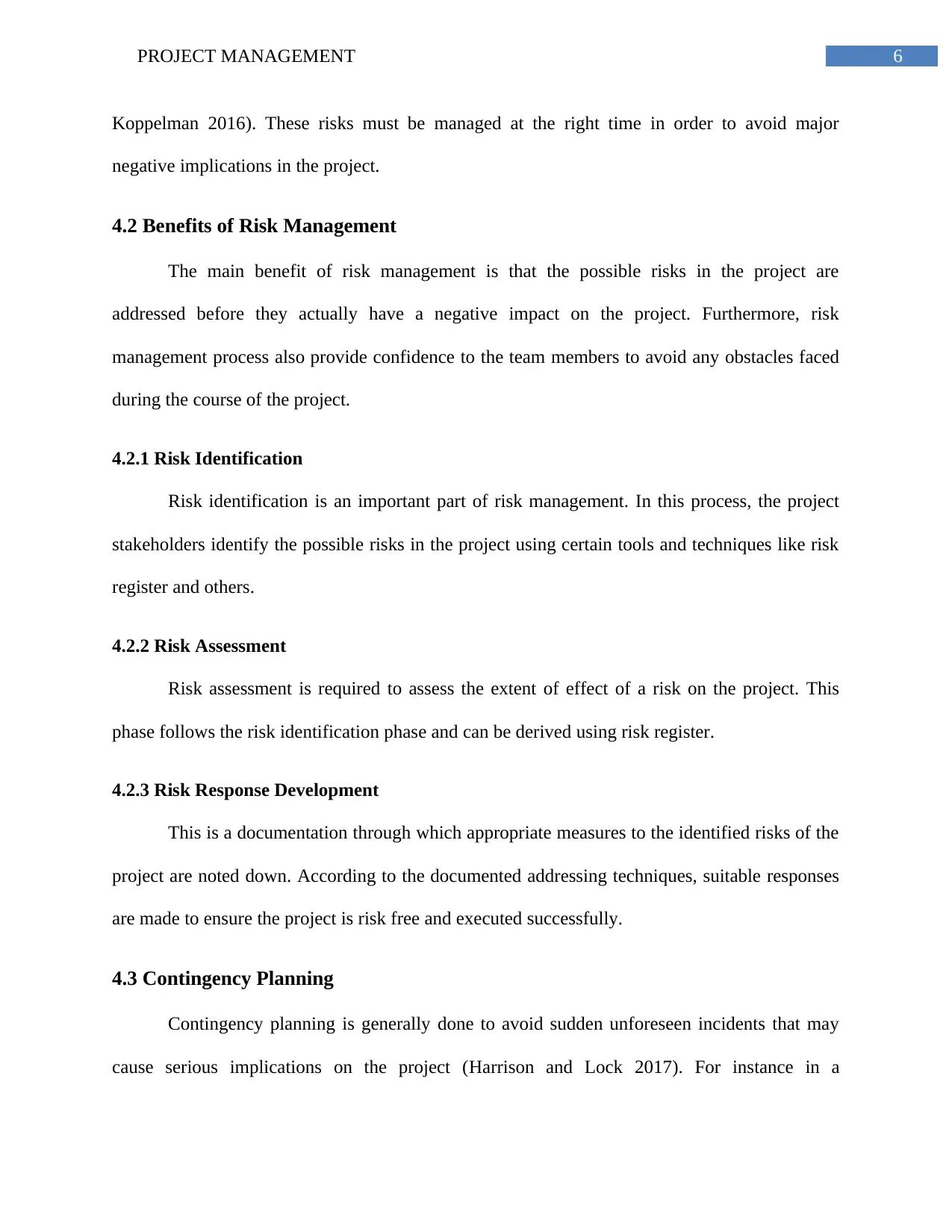
6PROJECT MANAGEMENT
Koppelman 2016). These risks must be managed at the right time in order to avoid major
negative implications in the project.
4.2 Benefits of Risk Management
The main benefit of risk management is that the possible risks in the project are
addressed before they actually have a negative impact on the project. Furthermore, risk
management process also provide confidence to the team members to avoid any obstacles faced
during the course of the project.
4.2.1 Risk Identification
Risk identification is an important part of risk management. In this process, the project
stakeholders identify the possible risks in the project using certain tools and techniques like risk
register and others.
4.2.2 Risk Assessment
Risk assessment is required to assess the extent of effect of a risk on the project. This
phase follows the risk identification phase and can be derived using risk register.
4.2.3 Risk Response Development
This is a documentation through which appropriate measures to the identified risks of the
project are noted down. According to the documented addressing techniques, suitable responses
are made to ensure the project is risk free and executed successfully.
4.3 Contingency Planning
Contingency planning is generally done to avoid sudden unforeseen incidents that may
cause serious implications on the project (Harrison and Lock 2017). For instance in a
Koppelman 2016). These risks must be managed at the right time in order to avoid major
negative implications in the project.
4.2 Benefits of Risk Management
The main benefit of risk management is that the possible risks in the project are
addressed before they actually have a negative impact on the project. Furthermore, risk
management process also provide confidence to the team members to avoid any obstacles faced
during the course of the project.
4.2.1 Risk Identification
Risk identification is an important part of risk management. In this process, the project
stakeholders identify the possible risks in the project using certain tools and techniques like risk
register and others.
4.2.2 Risk Assessment
Risk assessment is required to assess the extent of effect of a risk on the project. This
phase follows the risk identification phase and can be derived using risk register.
4.2.3 Risk Response Development
This is a documentation through which appropriate measures to the identified risks of the
project are noted down. According to the documented addressing techniques, suitable responses
are made to ensure the project is risk free and executed successfully.
4.3 Contingency Planning
Contingency planning is generally done to avoid sudden unforeseen incidents that may
cause serious implications on the project (Harrison and Lock 2017). For instance in a
Paraphrase This Document
Need a fresh take? Get an instant paraphrase of this document with our AI Paraphraser
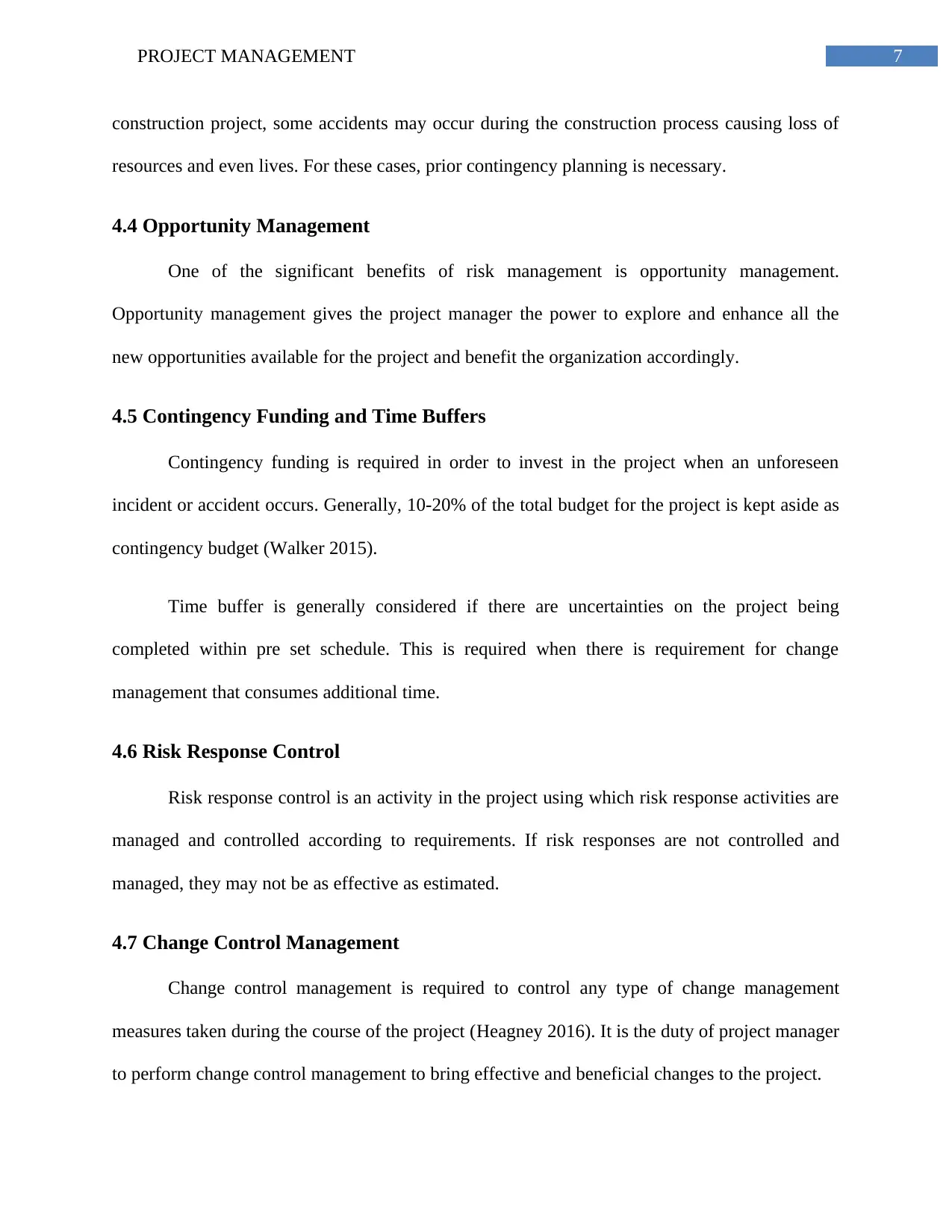
7PROJECT MANAGEMENT
construction project, some accidents may occur during the construction process causing loss of
resources and even lives. For these cases, prior contingency planning is necessary.
4.4 Opportunity Management
One of the significant benefits of risk management is opportunity management.
Opportunity management gives the project manager the power to explore and enhance all the
new opportunities available for the project and benefit the organization accordingly.
4.5 Contingency Funding and Time Buffers
Contingency funding is required in order to invest in the project when an unforeseen
incident or accident occurs. Generally, 10-20% of the total budget for the project is kept aside as
contingency budget (Walker 2015).
Time buffer is generally considered if there are uncertainties on the project being
completed within pre set schedule. This is required when there is requirement for change
management that consumes additional time.
4.6 Risk Response Control
Risk response control is an activity in the project using which risk response activities are
managed and controlled according to requirements. If risk responses are not controlled and
managed, they may not be as effective as estimated.
4.7 Change Control Management
Change control management is required to control any type of change management
measures taken during the course of the project (Heagney 2016). It is the duty of project manager
to perform change control management to bring effective and beneficial changes to the project.
construction project, some accidents may occur during the construction process causing loss of
resources and even lives. For these cases, prior contingency planning is necessary.
4.4 Opportunity Management
One of the significant benefits of risk management is opportunity management.
Opportunity management gives the project manager the power to explore and enhance all the
new opportunities available for the project and benefit the organization accordingly.
4.5 Contingency Funding and Time Buffers
Contingency funding is required in order to invest in the project when an unforeseen
incident or accident occurs. Generally, 10-20% of the total budget for the project is kept aside as
contingency budget (Walker 2015).
Time buffer is generally considered if there are uncertainties on the project being
completed within pre set schedule. This is required when there is requirement for change
management that consumes additional time.
4.6 Risk Response Control
Risk response control is an activity in the project using which risk response activities are
managed and controlled according to requirements. If risk responses are not controlled and
managed, they may not be as effective as estimated.
4.7 Change Control Management
Change control management is required to control any type of change management
measures taken during the course of the project (Heagney 2016). It is the duty of project manager
to perform change control management to bring effective and beneficial changes to the project.
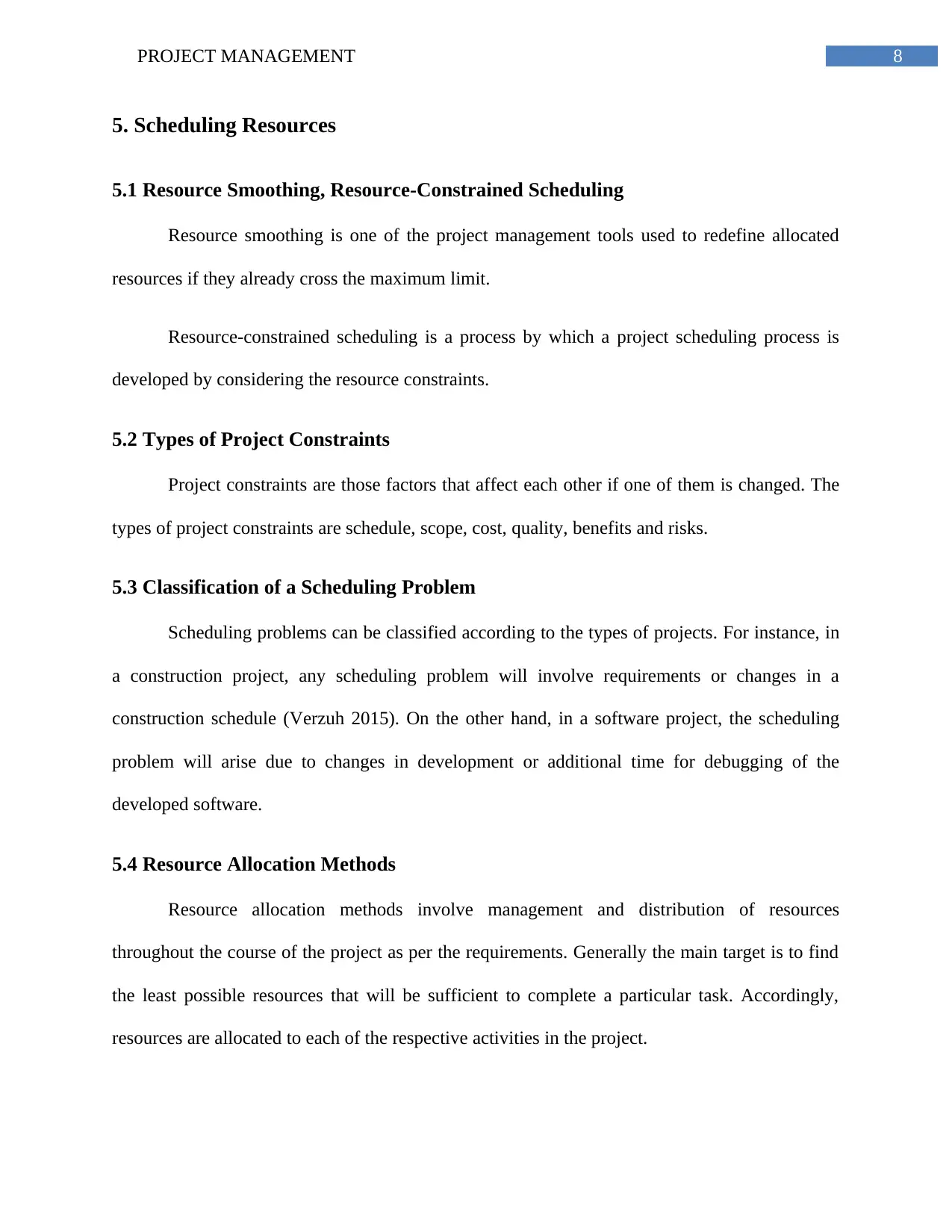
8PROJECT MANAGEMENT
5. Scheduling Resources
5.1 Resource Smoothing, Resource-Constrained Scheduling
Resource smoothing is one of the project management tools used to redefine allocated
resources if they already cross the maximum limit.
Resource-constrained scheduling is a process by which a project scheduling process is
developed by considering the resource constraints.
5.2 Types of Project Constraints
Project constraints are those factors that affect each other if one of them is changed. The
types of project constraints are schedule, scope, cost, quality, benefits and risks.
5.3 Classification of a Scheduling Problem
Scheduling problems can be classified according to the types of projects. For instance, in
a construction project, any scheduling problem will involve requirements or changes in a
construction schedule (Verzuh 2015). On the other hand, in a software project, the scheduling
problem will arise due to changes in development or additional time for debugging of the
developed software.
5.4 Resource Allocation Methods
Resource allocation methods involve management and distribution of resources
throughout the course of the project as per the requirements. Generally the main target is to find
the least possible resources that will be sufficient to complete a particular task. Accordingly,
resources are allocated to each of the respective activities in the project.
5. Scheduling Resources
5.1 Resource Smoothing, Resource-Constrained Scheduling
Resource smoothing is one of the project management tools used to redefine allocated
resources if they already cross the maximum limit.
Resource-constrained scheduling is a process by which a project scheduling process is
developed by considering the resource constraints.
5.2 Types of Project Constraints
Project constraints are those factors that affect each other if one of them is changed. The
types of project constraints are schedule, scope, cost, quality, benefits and risks.
5.3 Classification of a Scheduling Problem
Scheduling problems can be classified according to the types of projects. For instance, in
a construction project, any scheduling problem will involve requirements or changes in a
construction schedule (Verzuh 2015). On the other hand, in a software project, the scheduling
problem will arise due to changes in development or additional time for debugging of the
developed software.
5.4 Resource Allocation Methods
Resource allocation methods involve management and distribution of resources
throughout the course of the project as per the requirements. Generally the main target is to find
the least possible resources that will be sufficient to complete a particular task. Accordingly,
resources are allocated to each of the respective activities in the project.
⊘ This is a preview!⊘
Do you want full access?
Subscribe today to unlock all pages.

Trusted by 1+ million students worldwide
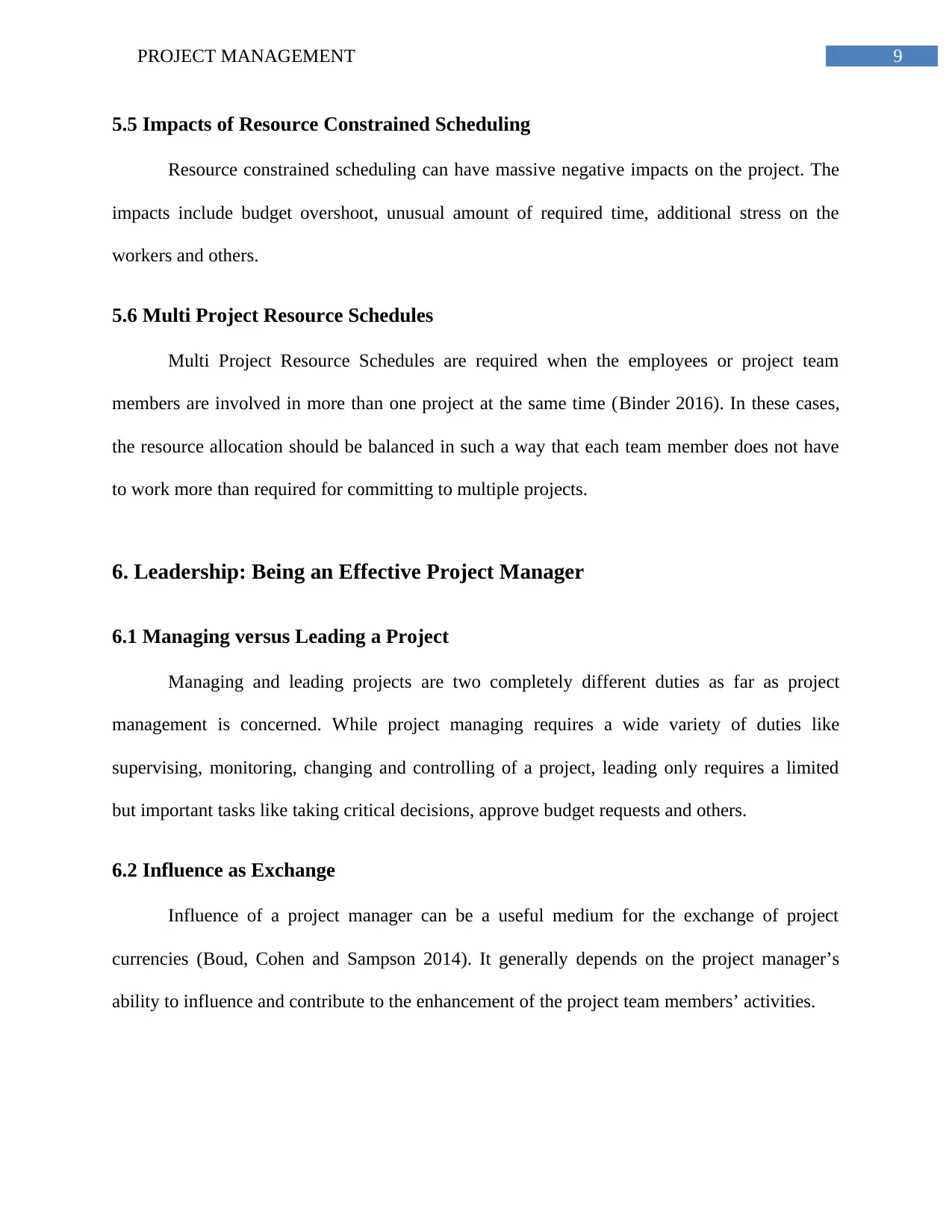
9PROJECT MANAGEMENT
5.5 Impacts of Resource Constrained Scheduling
Resource constrained scheduling can have massive negative impacts on the project. The
impacts include budget overshoot, unusual amount of required time, additional stress on the
workers and others.
5.6 Multi Project Resource Schedules
Multi Project Resource Schedules are required when the employees or project team
members are involved in more than one project at the same time (Binder 2016). In these cases,
the resource allocation should be balanced in such a way that each team member does not have
to work more than required for committing to multiple projects.
6. Leadership: Being an Effective Project Manager
6.1 Managing versus Leading a Project
Managing and leading projects are two completely different duties as far as project
management is concerned. While project managing requires a wide variety of duties like
supervising, monitoring, changing and controlling of a project, leading only requires a limited
but important tasks like taking critical decisions, approve budget requests and others.
6.2 Influence as Exchange
Influence of a project manager can be a useful medium for the exchange of project
currencies (Boud, Cohen and Sampson 2014). It generally depends on the project manager’s
ability to influence and contribute to the enhancement of the project team members’ activities.
5.5 Impacts of Resource Constrained Scheduling
Resource constrained scheduling can have massive negative impacts on the project. The
impacts include budget overshoot, unusual amount of required time, additional stress on the
workers and others.
5.6 Multi Project Resource Schedules
Multi Project Resource Schedules are required when the employees or project team
members are involved in more than one project at the same time (Binder 2016). In these cases,
the resource allocation should be balanced in such a way that each team member does not have
to work more than required for committing to multiple projects.
6. Leadership: Being an Effective Project Manager
6.1 Managing versus Leading a Project
Managing and leading projects are two completely different duties as far as project
management is concerned. While project managing requires a wide variety of duties like
supervising, monitoring, changing and controlling of a project, leading only requires a limited
but important tasks like taking critical decisions, approve budget requests and others.
6.2 Influence as Exchange
Influence of a project manager can be a useful medium for the exchange of project
currencies (Boud, Cohen and Sampson 2014). It generally depends on the project manager’s
ability to influence and contribute to the enhancement of the project team members’ activities.
Paraphrase This Document
Need a fresh take? Get an instant paraphrase of this document with our AI Paraphraser
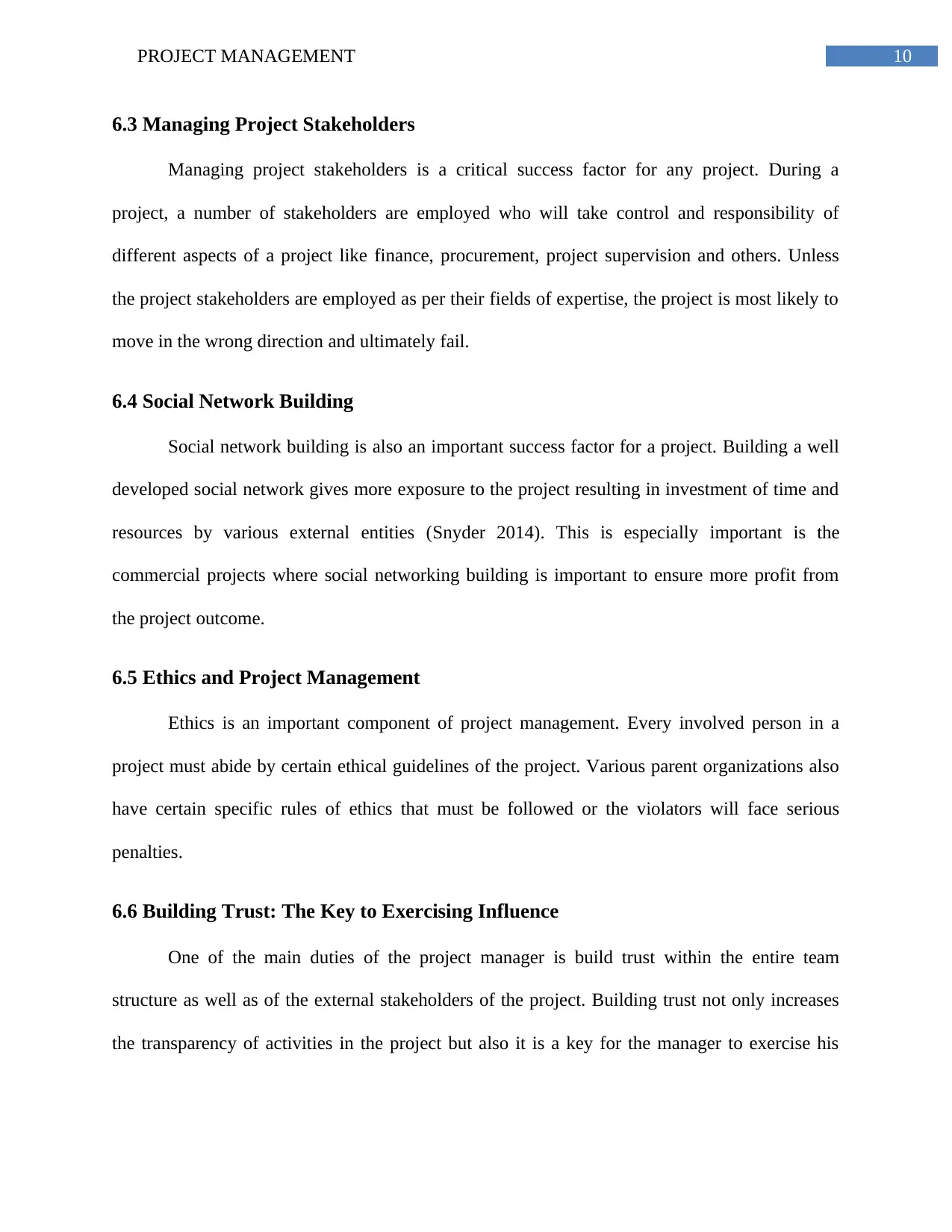
10PROJECT MANAGEMENT
6.3 Managing Project Stakeholders
Managing project stakeholders is a critical success factor for any project. During a
project, a number of stakeholders are employed who will take control and responsibility of
different aspects of a project like finance, procurement, project supervision and others. Unless
the project stakeholders are employed as per their fields of expertise, the project is most likely to
move in the wrong direction and ultimately fail.
6.4 Social Network Building
Social network building is also an important success factor for a project. Building a well
developed social network gives more exposure to the project resulting in investment of time and
resources by various external entities (Snyder 2014). This is especially important is the
commercial projects where social networking building is important to ensure more profit from
the project outcome.
6.5 Ethics and Project Management
Ethics is an important component of project management. Every involved person in a
project must abide by certain ethical guidelines of the project. Various parent organizations also
have certain specific rules of ethics that must be followed or the violators will face serious
penalties.
6.6 Building Trust: The Key to Exercising Influence
One of the main duties of the project manager is build trust within the entire team
structure as well as of the external stakeholders of the project. Building trust not only increases
the transparency of activities in the project but also it is a key for the manager to exercise his
6.3 Managing Project Stakeholders
Managing project stakeholders is a critical success factor for any project. During a
project, a number of stakeholders are employed who will take control and responsibility of
different aspects of a project like finance, procurement, project supervision and others. Unless
the project stakeholders are employed as per their fields of expertise, the project is most likely to
move in the wrong direction and ultimately fail.
6.4 Social Network Building
Social network building is also an important success factor for a project. Building a well
developed social network gives more exposure to the project resulting in investment of time and
resources by various external entities (Snyder 2014). This is especially important is the
commercial projects where social networking building is important to ensure more profit from
the project outcome.
6.5 Ethics and Project Management
Ethics is an important component of project management. Every involved person in a
project must abide by certain ethical guidelines of the project. Various parent organizations also
have certain specific rules of ethics that must be followed or the violators will face serious
penalties.
6.6 Building Trust: The Key to Exercising Influence
One of the main duties of the project manager is build trust within the entire team
structure as well as of the external stakeholders of the project. Building trust not only increases
the transparency of activities in the project but also it is a key for the manager to exercise his
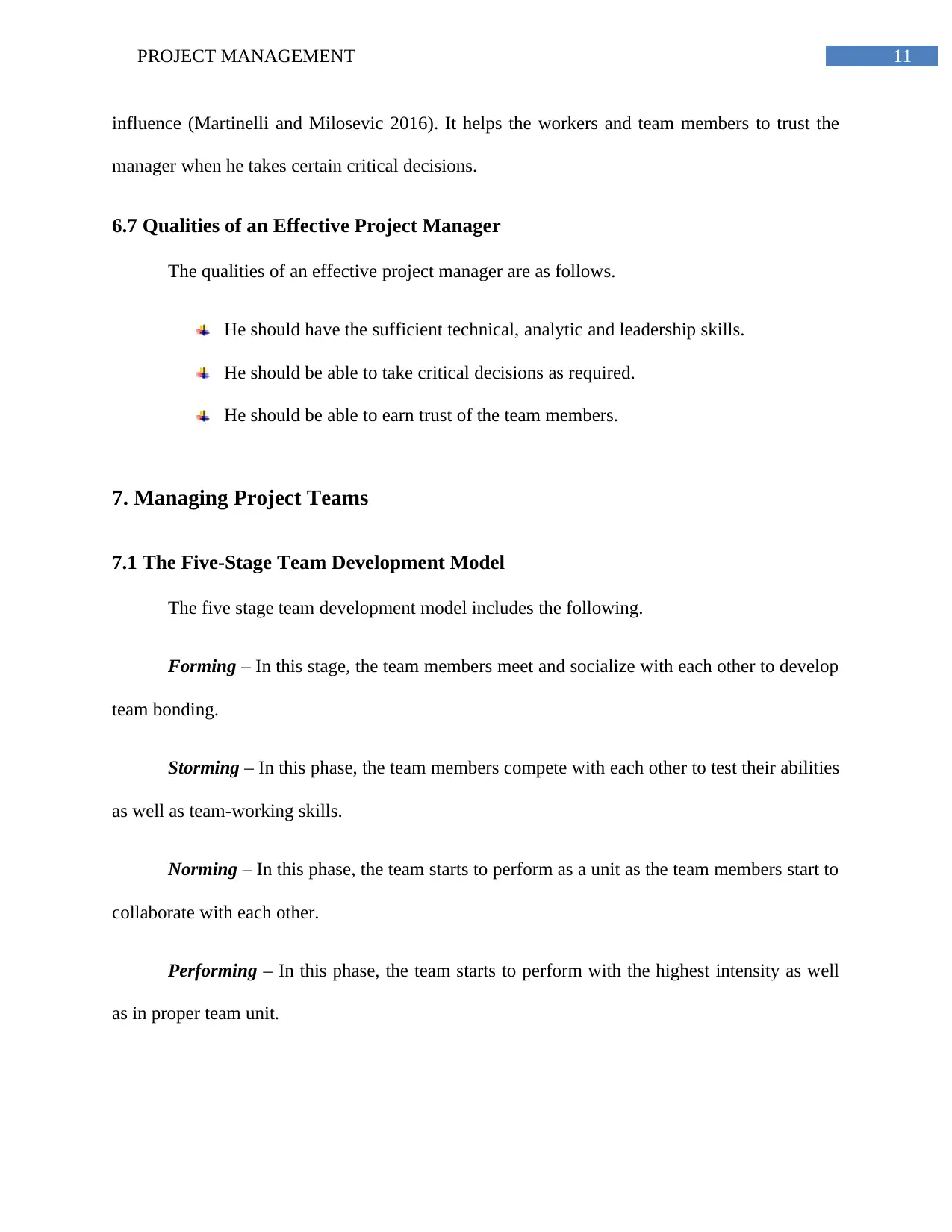
11PROJECT MANAGEMENT
influence (Martinelli and Milosevic 2016). It helps the workers and team members to trust the
manager when he takes certain critical decisions.
6.7 Qualities of an Effective Project Manager
The qualities of an effective project manager are as follows.
He should have the sufficient technical, analytic and leadership skills.
He should be able to take critical decisions as required.
He should be able to earn trust of the team members.
7. Managing Project Teams
7.1 The Five-Stage Team Development Model
The five stage team development model includes the following.
Forming – In this stage, the team members meet and socialize with each other to develop
team bonding.
Storming – In this phase, the team members compete with each other to test their abilities
as well as team-working skills.
Norming – In this phase, the team starts to perform as a unit as the team members start to
collaborate with each other.
Performing – In this phase, the team starts to perform with the highest intensity as well
as in proper team unit.
influence (Martinelli and Milosevic 2016). It helps the workers and team members to trust the
manager when he takes certain critical decisions.
6.7 Qualities of an Effective Project Manager
The qualities of an effective project manager are as follows.
He should have the sufficient technical, analytic and leadership skills.
He should be able to take critical decisions as required.
He should be able to earn trust of the team members.
7. Managing Project Teams
7.1 The Five-Stage Team Development Model
The five stage team development model includes the following.
Forming – In this stage, the team members meet and socialize with each other to develop
team bonding.
Storming – In this phase, the team members compete with each other to test their abilities
as well as team-working skills.
Norming – In this phase, the team starts to perform as a unit as the team members start to
collaborate with each other.
Performing – In this phase, the team starts to perform with the highest intensity as well
as in proper team unit.
⊘ This is a preview!⊘
Do you want full access?
Subscribe today to unlock all pages.

Trusted by 1+ million students worldwide
1 out of 17
Related Documents
Your All-in-One AI-Powered Toolkit for Academic Success.
+13062052269
info@desklib.com
Available 24*7 on WhatsApp / Email
![[object Object]](/_next/static/media/star-bottom.7253800d.svg)
Unlock your academic potential
Copyright © 2020–2025 A2Z Services. All Rights Reserved. Developed and managed by ZUCOL.




